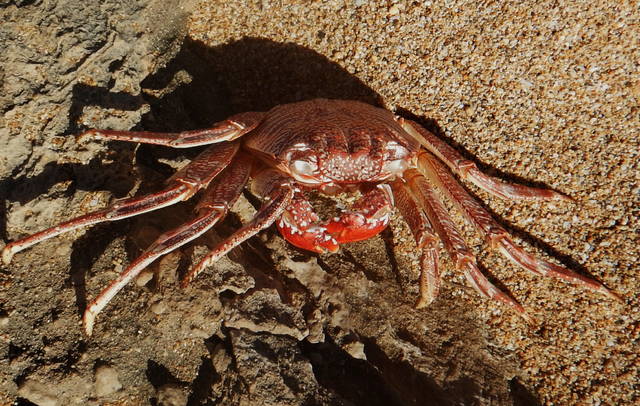Published in the Ocean Watch column, Honolulu Star-Advertiser © Susan Scott
April 1, 2017
While visiting Molokai last weekend, friends and I went to Moomomi Preserve, a 912-acre coastal area shaped by tradewinds so gusty they sandpapered our legs. It was worth the prickles.
Behind the beach stands a mile of dunes, wind-sculpted into bluffs of rippled sand. Since 1988, when the Nature Conservancy and the state’s DLNR began fencing Moomomi, several hundred wedge-tailed shearwaters have claimed the land above and behind the bluffs. Protected from predators, the seabirds dig their ground nests in peace, and the 22 native plants that grow there get their sandy soil aerated.
 An aama molt is seen at Moomomi beach on Molokai. The shell of the Hawaiian black
An aama molt is seen at Moomomi beach on Molokai. The shell of the Hawaiian black
rock crab shows its true colors detached in the hot sun. The crustaceans molt their
exoskeletons by separating skin from shell, then cracking a rear seam to exit from.
©2017 Susan Scott
During our walk through this picture of ancient Hawaii, flocks of shorebirds called out over the roar of crashing waves, and turtles left behind their signature tracks.
Surprisingly, amid all this burrowing, booming and blowing, I found a fragile but intact remnant of a remarkable marine animal: the rock crab.
Hawaii’s rock crabs, also called aama, are the flat, black crabs we see hanging out on Hawaii’s basalt beaches and concrete breakwaters. When startled, the crabs skitter into cracks or jump into the water so fast you wonder what you really saw.
One Hawaii blogger calls our rock crab a “hot-rod decapod,” decapod meaning 10 legs.
Aama’s close relative is the well-named Sally Lightfoot crab, found on coasts in the eastern tropical Pacific. Sallys are easy to find because they’re bright red. Aama shells turn red, too, but never while they’re still wearing them.
Because crustaceans carry their skeletons on the outside of their skin, and those skeletons don’t expand, the creatures have to shed their shells to grow. The process resembles science fiction.
When it’s time to go up a size, the crab starts absorbing calcium carbonate from its old shell and begins secreting enzymes that separate skin from shell. The absorbing and secreting can take a few weeks.
On the big day the crab sucks seawater into its body and swells up like a balloon. This cracks the old shell along a rear seam, creating a backdoor exit. The crab pulls its body through the slit, taking its legs, eyestalks, antennae, mouth parts and gills with it.
As the crab recycles its absorbed calcium carbonate to make a new shell, it gradually replaces the inhaled seawater with protein.
When the sun hits the paper-thin molt left behind, the heat destroys the cells’ dark proteins. We then see the aama’s true colors: red and white.
We don’t see them for long. Sun and rain quickly break down the delicate molts, and soon they’re gone with the wind.
Finding a perfect, whole aama molt reminded me of the marvelous way our little hot-rod decapods grow.
Thank you, Nature Conservancy and state DLNR, for having the foresight to preserve and protect this extraordinary place.